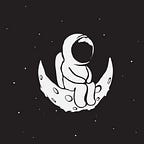The remarkable drama of Luna
The history of spaceflight contains many incredible, inspiring stories. And, sometimes, when it goes badly wrong. These are those stories.
When you are asked to think of missions to the moon, do you immediately imagine NASA’s famous Apollo missions?
Obviously, there’s Apollo 11, and for extra nerdy points, you might mention the last crewed mission — Apollo 17, in 1972, and how Gene Cernan carved his daughter’s initials on the lunar surface.
You might also mention China’s recent Chang’e-4 mission, the first to land on the far side of the moon, or you might be excited about the Israeli mission that accidentally stranded tardigrades on the moon [side note: anyone keen for a future post about that mission?].
What you might not realise, if you include all Moon missions that impacted the surface — some more deliberately than others — is that there have been about 50 spacecraft on our lunar satellite.
Long before any successful missions to the dark side of the moon, and predating Apollo 11 by a decade, the Soviet Union was working hard on its luna programme — but it was off to a rocky start.
It’s not rocket science
In 1958, it was September and less than a month after it was decreed that automated luna probes would be launched. The Luna E-1 spacecraft unceremoniously disintegrated 93 seconds after launch.
Not to be dissuaded, just weeks later, they tried again. This time the new and improved Luna E-1 spacecraft disintegrated 104 seconds after launch.
The relative success of the second launch spurred on further activity. It was December, and Luna E-1 burnt down, fell over, then sank into the swamp.
To be slightly more accurate, it didn’t disintegrate, instead, the core engines shut off after 245 seconds into the flight.
A small disclaimer here, I am not a rocket scientist, as you might have noticed. Although I am told that the phrase “it’s not rocket science” is a little misplaced because rocket science is not complicated. It should instead be “it’s not rocket propulsion.” But anyway. Even though I am not a rocket scientist, I am fairly sure it helps if the engines don’t shut off.
New year, new you
A new year is a good time to start pursuing new hobbies and interests. But if you’re the Soviet Union in the 1950s, it’s a good time to continue launching the Luna E-1 spacecraft.
And they were right to do so. Being Russian (or Soviet) they naturally took New Year’s Day off work, and on January 2 were straight back to launching spacecraft at the moon. Or trying to.
Luna E-1 Number 4 launched on a (deliberate) collision course with the moon. This time, everything was going right. For a start, it didn’t disintegrate. That’s a big tick, and puts it ahead of Luna E-1 Numbers 1 and 2.
Unlike Luna E-1 Number 3, its engines all worked as expected. The rocket engineers didn’t trust automated systems for controlling engine burns, so to avoid a repeat of the last Luna’s problems, the engines were expertly controlled by radio, instead.
Luna 1 achieved escape velocity and sailed off into the ether of outer space, bound to crash into the moon — in the solemn name of science.
It’s hard to imagine how a spacecraft deliberately designed to crash can go wrong, when it doesn’t disintegrate seconds into its launch. Surely, once the engines are working, you point it at the moon, then go put the kettle on and wait for a couple of days.
From little delays, big mistakes grow
Remember how engineers controlling the engine burn didn’t trust automated systems? A slight delay in their signal to stop the engines gave the spacecraft an unintended extra 175 m/s.
Over the vast expanse of space, this added up to missing its target by 6,000 kilometres.
Today, Luna E-1 is also known as Мечта (roughly translated as “dream”) and continues impotently orbiting the sun.
Its batteries ran out after a few days, but that small spherical, pressurised container continues to not crash into anything some 61 years, 3 months, and 14 days after it launched on a simple mission of crashing into the moon.
